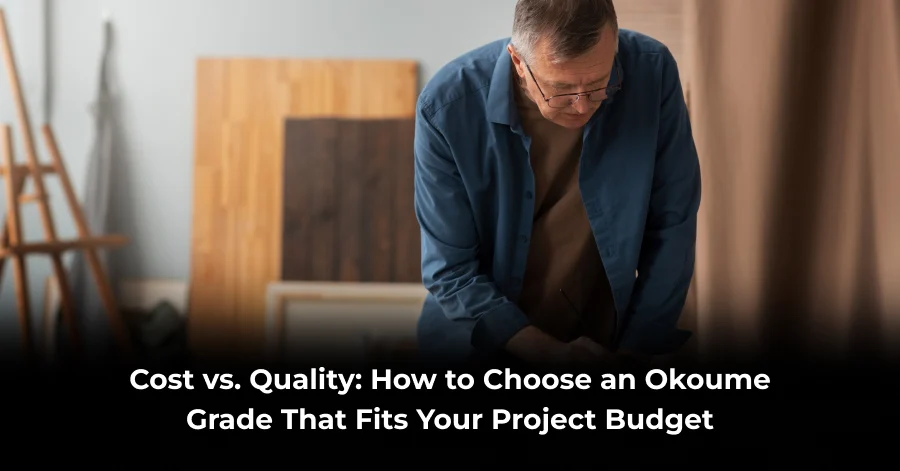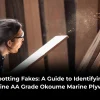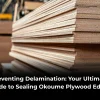Welcome to the workshop. The scent of fresh sawdust is in the air, and you’re standing before a stack of beautiful, pale pinkish-brown Okoume wood. Your plans are drawn, your tools are sharpened, but there’s one critical decision left: which grade of this versatile African hardwood do you choose? This choice, often seen as a tug-of-war between your vision and your wallet, is one of the most fundamental steps in any project. It’s the moment where a dream meets reality, and making the right call can be the difference between a project you’re proud of for years and one that frustrates you at every turn.
For anyone passionate about woodworking, from building a feather-light kayak to crafting elegant cabinetry, understanding the wood grading system is like learning the language of the material itself. It’s not about “good” vs. “bad” wood; it’s about “right” vs. “wrong” for your specific project. At its heart, this guide is about empowering you to make an informed choice that balances cost and quality without compromising the integrity of your work. As you browse your favorite woodworking supplies store, whether online or in-person, you’ll be able to confidently select the perfect okoume wood for your needs, speaking the language of grades like a seasoned pro.
Getting to Know Okoume: The “African Mahogany”
Before we dive into grades, let’s appreciate the wood itself. Okoume wood (pronounced oh-KOO-may), sometimes called Gaboon, is a prized import from West-central Africa. It’s not a true mahogany, but its fine, even texture, straight grain, and stunning pale rose hue have earned it a beloved place in the woodworking world. Its most celebrated qualities are its light weight and exceptional stability. This makes it the go-to choice for marine plywood in boat building, as well as for architectural veneers, musical instruments, and fine furniture.
But what does this mean for you in the workshop? The light weight means easier handling of large sheets, less fatigue during assembly, and a final product that is surprisingly easy to move—a huge benefit for furniture like large coffee tables or cabinet doors. The stability is its secret weapon; okoume wood has a minimal tendency to shrink, swell, or warp compared to many other species. This predictability is a woodworker’s best friend, leading to tighter joints and a longer-lasting final product. When you’re sourcing materials from a reputable woodworking supplies store, you’ll find okoume wood primarily in two forms: solid lumber and plywood. The grading principles apply to both, but for this guide, we’ll focus on the plywood, where the wood grading system is most prominently used and crucial for project success.
Decoding the Language: The Wood Grading System Explained
The wood grading system for hardwood plywood, including okoume wood, can seem cryptic at first glance. It’s essentially a report card for each panel, evaluating the quality of the two face veneers and the inner core. The grade is typically expressed as a combination of two letters (e.g., A-A, A-B, B-B). The first letter refers to the quality of the “face” veneer (the pretty side you’ll see), and the second letter refers to the quality of the “back” veneer. Think of it as buying a suit; the front lapel might be pristine (A), while the inside lining might be functional but not the star of the show (B).
Let’s break down what these letters mean in practical, human terms:
- A-Grade: This is the cream of the crop. An “A” face is smooth, virtually defect-free. It may have tiny, neatly made repairs (like football-shaped patches or filler) but is intended for a clear, natural finish. If you plan on staining your project to show off the beautiful grain of the okoume wood, this is your grade. It’s the choice for heirloom pieces where the wood’s natural beauty is the central focus.
- B-Grade: A step down in appearance, but not in structural integrity. A “B” face will have more noticeable characteristics. Think small, tight knots, mineral streaks, or slight discolorations. For a project where the wood will be painted, or where a more rustic, character-filled look is desired, B-grade offers fantastic value. These aren’t flaws; they’re features that add a story to the wood.
- C-Grade: This grade allows for more significant defects, such as larger knots, splits, and plugs. It’s rarely used as a face veneer in fine woodworking but is a common backer for sheet goods (e.g., an A-C panel) or for structural components that will never be seen. It’s the unsung hero that provides strength where looks don’t matter.
- D-Grade: The most economical option, with numerous and larger defects. This is purely utilitarian, used for backing or in construction where appearance is zero concern. You’re unlikely to use this for a fine woodworking project unless it’s for a temporary jig or a hidden brace.
Seeing wood grade images is incredibly helpful. A good woodworking supplies store will provide clear wood grade images on their product pages. Studying these wood grade images will give you a better visual understanding of the differences between an A, B, and C face than any written description can. When you look at wood grade images, pay attention to the size and frequency of knots and the color consistency across the sheet. This visual reference is an indispensable tool for making your choice.
The Heart of the Matter: Aligning Grade with Project and Budget
Now, let’s apply this knowledge. How do you choose? It comes down to three questions: What is the project? How will it be finished? And what is your budget? Let’s walk through some common scenarios you might encounter when planning your purchase from a woodworking supplies store.
Scenario 1: The Showpiece Project (The “A-A” or “A-B” Choice)
- Project Examples: A custom speaker cabinet with a clear lacquer finish, a dining table with a natural oil finish, the deck of a show-quality sailboat, a guitar body.
- Reasoning: For these projects, the wood is the star. The beauty of the okoume wood grain is a central design element. Using anything less than an A-grade face would mean that natural imperfections like knots or patches would distract from the intended elegance. The cost is higher, but for a showpiece, the material cost is a justified investment. You’re paying for visual perfection.
- Budget Tip: If only one side will be visible (like a tabletop or the exterior of a cabinet), consider an A-B panel. You get a pristine face for a lower price than an A-A panel, as the hidden back is a more economical B-grade. This is a classic cost-saving strategy within the wood grading system that every experienced woodworker uses. It’s a smart way to allocate your budget where it counts.
Scenario 2: The Painted Masterpiece or Character-Rich Build (The “B-B” Choice)
- Project Examples: A painted bookcase, the interior hull of a boat that will be painted, a workbench top where durability matters more than perfection, built-in shelving units.
- Reasoning: Why pay for perfection you’re going to cover up? If your project is destined for a coat of paint, the flawless surface of an A-grade face is unnecessary. A B-grade face of okoume wood is structurally sound and provides a perfectly smooth base for paint after a little filling and sanding. The knots and streaks can add wonderful character if you’re going for a natural, rustic look. This is where the wood grading system saves you significant money without sacrificing performance. It’s the practical choice for beautiful results.
- Budget Tip: A B-B panel is often the best value-for-money option for a huge range of projects. It’s the workhorse of the woodworking supplies store. The savings over A-A can be substantial, allowing you to invest in better hardware or tools for the same overall budget.
Scenario 3: The Structural/Unseen Component (The “C-C” or Shop Grade Choice)
- Project Examples: Internal framing for a cabinet, jigs and fixtures for your workshop, the core layer in a laminated beam, drawer sides that will be hidden.
- Reasoning: This is all about function. If the wood will never be seen, its appearance is irrelevant. The structural properties of okoume wood—its strength and stability—are still present, making it an excellent choice. Spending on a higher grade here is simply a waste of resources that could be better allocated to the visible parts of your project. Using a lower grade for these parts is a sign of smart project management, not cutting corners.
Navigating this choice is a key skill. A knowledgeable woodworking supplies store can be an invaluable resource, helping you match the okoume wood grade to your project’s demands. Don’t hesitate to describe your project to them; their experience can prevent costly over-buying or disappointing under-buying.
Also Read: Okoume Wood Grade Images: A Visual Comparison Guide [2025]
Beyond the Grade: Other Cost Factors
The veneer grade is the main price driver, but other factors influence the final cost. When you’re comparing prices at your woodworking supplies store, keep these in mind:
- Core Type: Plywood can have a veneer core (traditional, made of layered wood), MDF core (ultra-smooth and perfect for detailed CNC machining or preventing telegraphing), or a composite core (often waterproof and incredibly stable for marine use). Each core type has different price points and applications. An MDF core, for example, might cost more than a standard veneer core but provides an exceptionally flat surface for painting.
- Thickness: Obviously, thicker sheets cost more, but they also offer greater rigidity and strength. Ensure your project plans specify the correct thickness for your okoume wood to avoid using a panel that’s too weak or unnecessarily expensive.
- Certifications: Wood with certifications like FSC (Forest Stewardship Council) may carry a small premium but ensure the wood was harvested in an environmentally and socially responsible way. For many woodworkers, this sustainable sourcing is a value worth paying for.
Why AEW Wood Is a Name You Can Trust
When you’re investing time and money into a project, the source of your materials matters as much as the materials themselves. This is where a specialist like AEW Wood shines. For decades, AEW Wood has established itself as a premier importer and supplier of exceptional hardwood plywoods, including a wide selection of okoume wood. They are more than just a woodworking supplies store; they are curators of quality.
What sets a company like AEW Wood apart? It’s their deep specialization and commitment to quality control. They understand the nuances of the wood grading system inside and out, ensuring that when you order an A-grade sheet, it consistently meets high expectations. They provide accurate, high-resolution wood grade images and detailed product descriptions, so you know exactly what you’re getting before it arrives at your door. Their expertise is particularly crucial for a material like okoume wood, which is often used in demanding applications like marine construction where quality is non-negotiable. Sourcing your okoume wood from a dedicated supplier like AEW Wood means you’re getting a product that has been professionally graded, stored, and handled with care, giving you peace of mind and a superior building experience from start to finish.
Conclusion
The journey through the world of okoume wood and its grading is a perfect metaphor for woodworking itself: it’s about making smart, informed choices. The wood grading system isn’t a barrier; it’s a tool for empowerment. By understanding what the letters A, B, and C truly represent, you can strategically manage your project budget without compromising on the final outcome. It allows you to spend where it’s seen and save where it’s not, a principle that defines professional-quality work.
Remember, the “best” okoume wood isn’t always the most expensive; it’s the grade that is perfectly suited to your project’s function, finish, and financial plan. Don’t be afraid to lean on the expertise of specialized suppliers. A great woodworking supplies store, especially one with a focus like AEW Wood, is a partner in your creative process. They can provide the clarity, quality, and crucial wood grade images you need to bring your vision to life beautifully and efficiently. So, choose confidently, build joyfully, and let the unique character of okoume wood shine in your next masterpiece. Your perfect project, balanced beautifully between cost and quality, awaits.
Frequently Asked Questions (FAQs)
- Can I sand out the defects in a lower grade of Okoume plywood?
Unfortunately, no. The veneers on hardwood plywood are very thin (often less than 1/40th of an inch). Sanding aggressively to remove a knot or patch will likely sand right through the veneer, exposing the core beneath, which will ruin the finish. It’s always better to choose a grade that aligns with your finishing plans from the start. - Is all “A” grade wood exactly the same?
While the wood grading system provides standards, there can be slight variations in interpretation between different mills and suppliers. This is why reviewing the wood grade images provided by your woodworking supplies store is so important. Reputable suppliers like AEW Wood are consistent and transparent in their grading, building trust with their customers. - Is Okoume wood strong enough for outdoor use?
Solid okoume wood is not rot-resistant and is not recommended for prolonged, unprotected outdoor exposure. However, okoume wood marine plywood, when constructed with waterproof glue and properly sealed on all edges and surfaces with epoxy and UV-resistant paint, is excellent for boat building and other marine applications. The key is a complete and durable moisture barrier. - What’s the difference between Okoume and true Mahogany?
True mahoganies (like Genuine Mahogany) are generally denser, harder, and more durable, making them suitable for high-wear items like flooring. Okoume wood is lighter and softer but shares a similar aesthetic with a often straighter, more uniform grain. Okoume is typically more affordable and is a fantastic alternative for projects where weight is a primary concern, such as in boatbuilding or portable furniture. - For a beginner, which grade of Okoume should I start with?
For your first project, a B-B grade is an excellent choice. It’s more forgiving of mistakes—a small glue drip or an accidental ding won’t be as tragic as on a pristine A-grade face—and is more budget-friendly. This reduces the stress of learning and allows you to focus on mastering techniques without the fear of wasting expensive materials.






